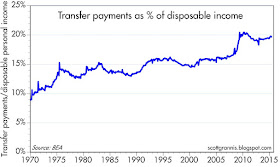For the past 4 years, the private sector has been adding new jobs at a 2.25% annualized rate, and the June jobs report released today was simply more of the same. That, coupled with meager growth in productivity, has given us the weakest recovery on record. The good new is that jobs continue to expand and the economy continues to grow, and things continue to get better. And there is no sign of another recession.
The private sector has created almost 13 million jobs in the past 5 years, but the net gain from the prior expansion's peak has only been about 4 million. That works out to a net gain of only about 0.5% per year. We could be doing a lot better: in the 1980s, the net gain in jobs, despite back-to-back recessions in 1981 and 1982, was about 2% per year. That kind of growth would have given us almost 15 million more jobs today.
As the chart above shows, June's gain of 223K was just about equal to the average of the current expansion, but a little better than the average gains of the previous expansion.
On a percentage basis, jobs growth in the current expansion has actually been somewhat stronger—and longer lasting—than in the previous expansion, but a good deal less than the 3.2% annualized growth in private sector jobs in the 1982-2000 expansion.
So what's different this time around? As the chart above shows, transfer payments relative to disposable income have grown some 50% since the 1980s (from 13% of disposable income to almost 20%). Transfer payments represented about 45% of federal government spending in the 1980s, while today they represent almost 75%. To be sure, the baby boomers have added significantly to the ranks of the retired in recent years. But other programs, such as disability, medicare, medicaid, food stamps have experienced explosive growth. We should not be surprised that paying more and more people for not working results in fewer people willing to work. At the same time, the cost of hiring workers has risen, thanks to mushrooming regulatory burdens (e.g., Obamacare and higher minimum wages).
We are unlikely to see a significant pickup in growth and employment until we see pro-growth reforms coming out of Washington (e.g., reduced regulatory and tax burdens, and entitlement reforms).
In the absence of any evidence of deterioration in the economic and financial market fundamentals, and given the continued 2-2.5% growth in the economy, a modest increase in interest rates poses no threat to the economy. Economic growth is slow because of government-induced headwinds, not because of any lack of money or interest rates that are too high. The Fed is likely going to play it safe and wait a bit more to raise rates, but it's not going to make much difference to the economy.





Hourly wages in May were up 2% year-over-year. No concerns about inflation in this regard.
ReplyDeleteThe Fed could be more aggressive in promoting growth.
Ponder this: How would voters feel about free enterprise and capitalism if there were chronically very tight labor markets?
Conversely, how would voters feel about free enterprise and capitalism if there were persistently high unemployment?
We can reduce transfer payments, but it would help if there were strong labor markets first. We can also cut national security spending in half, with very little risk. The Cato Institute recommends as much.
Scott wrote: "Economic growth is slow because of government-induced headwinds, not because of any lack of money or interest rates that are too high."
ReplyDeleteFrom what I have read from several sources and posted on this blog, economic growth is usually low primarily because of the small increase in the working age population of about 1% per year due to demographics and because of the very low 1/2 - 1% annual increase in productivity which has been the case for the past 2 - 3 years. Until either of those improve we can't expect real GDP growth of much more than 2% per year.
Thus the Federal Reserve's (and Benjamin's) policies directed at increasing Demand are hopeless since the real US growth problem is on the Supply side.
William: choke off demand and see what happens to supply.
ReplyDeleteYou don't have to do anything for demand or the supply side if you could find a way to reduce prices. Two units in my small apartment house just went to two couples paying $2175 per month for 650 sq ft 1 bedroom apartments. One young husband is a gamer software engineer and the other husband a structural engineer. Their young wives respectively are a geneticist and the other has a medical specialty. Everyone thinks that this is just peachy keen that there are such highly educated bright young people. But all they are economically speaking is a conduit of money from the successful Silicon Valley businesses to landlords. Not to mention they probably have student loans which simply made them conduits of money to the education cartel. They are also conduits of company money to retired people whose ranks are growing at such a fast pace they are becoming blood suckers . It is a battle of oligopolies over exacting money from young people. Forget free markets-what a joke. The home owners in the area adamantly refuse to increase available housing to reduce the cost of rents. So all that money going to landlords doesn't go to increasing the housing supply it just goes into the stock market where it dies.
ReplyDeleteJoe--I am sure that in the City of San Clemente (Scott Grannis' hometown) they are very receptive to 60-story condo towers with ground-floor retail.
ReplyDeleteCommunities such as Newport Beach and San Clemente believe in free enterprise and private property rights, but bureaucrats in Washington DC won't let them build housing!